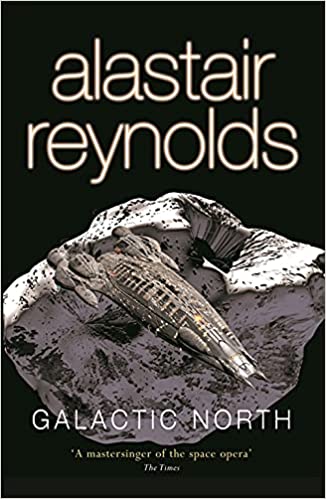Galactic North by Alastair Reynolds is a key book of short stories for understanding many aspects of the Revelation Space universe. The novels and stories within that universe follow human settlement of many star systems over several centuries. In the course of this future history, humans adapt in many ways, especially through the use of cybernetic implants and nanotechnology. Among those adaptative societies are the Conjoiners, a networked community of human minds, that is at war with other human groups, especially the Demarchists and the Ultras. The eight stories of Galactic North provide important details about these groups, especially the Conjoiners. I’m especially interested in them because their unique form of collective consciousness raises so many ideas about communication and human relationships.
Rather than summarize all the stories in this post, I will look at two (“The Great Wall of Mars” and “Weather”) that not only describe how a collective intelligence works but probes the human connection that remains possible even after one person is absorbed into a network of minds. Since this is an older book, really a classic that is summarized in detail in Wikipedia, along with several other entries on Revelation Space, there will be major spoilers ahead for these two stories.
Reynolds is meticulous with the chronology of his future history, setting most of the novels and stories between 2200 and 2858, but the early history extends back a billion years and forward as far as 40,000 CE. Galactic North begins with the novella, “The Great Wall of Mars,” which takes place around 2200, when humans have settled several planets and moons of the solar system. War has been ongoing between the Conjoiners and a Coalition for Neural Purity that includes a faction known as the Demarchists. Sandra Voi, a Demarchist leader, joins Nevil Clavain on a diplomatic expedition from Deimos, a moon of Mars, to the surface of the planet to negotiate with Galiana, one of the founders of the Conjoiners.
The city or nest of the Conjoiners consists of a series of levels extending deep under the surface of Mars and constructed within a massive and once-living wall. The wall was an alternative to planet-wide terraforming and allowed the development of an earth-like atmosphere within a small area that gradually expanded as the wall grew outward to a width of two thousand kilometers. It entrapped its own weather system and within its boundaries numerous small domes were constructed, all connected by a series of tunnels. During the war, the wall was hit by a viral weapon that damaged its inner structures, so it stopped growing and was gradually failing. The Conjoiners built their nest in a small area within the wall, and Galiana not only reveals the full structure of its many levels to Clavain, she also, under pretext of healing a head wound, introduces the nano-scale machines, or medechines, into his bloodstream that begin to grow throughout the neural structure of his brain. He is not completely transformed but changes enough so that he can begin to perceive the structures of the Conjoiner world that are invisible to normal humans.
So through his eyes, we see the complex weaving of connections throughout the structure of the nest that enable the Conjoiners to commune with each other in a state they call Transenlightenment. While most humans abhor Conjoiners as freakish hive mind robots, they are nothing of the sort. As Galiana explains, they are not clones but individuals whose memories and experiences are joined through their neural connections to enable them to achieve a special state of consciousness. They are like a network of nodes that can exist apart from each other but are at their peak when in the proximity of their nest.
When Clavain begins to experience this radically different consciousness, even imperfectly, he is at a loss for words because “evolution had shaped language to convey many concepts, but going from a single to a networked topology of self was not amongst them.” His mind latches onto metaphor to help him comprehend the experience:
“It was like standing on the shore of an ocean, being engulfed by a wave taller than himself. For a moment he sought the surface; tried to keep the water from his lungs. But there happened not to be a surface. What had consumed him extended infinitely in all directions. He could only submit to it. Yet as the moments slipped by, it turned from something terrifying in its unfamiliarity to something he could begin to adapt to; something that even began in the tiniest way to feel comforting. Even then he glimpsed that it was only a shadow of what Galiana was experiencing every instant of her life. … The fullness of Transenlightenment retreated, like a fading vision of Godhead. What he was left with was purely sensory, lacking any direct rapport with the others. His state of mind came crashing back to normality.”
Galactic North, Kindle edition, Page 34
The difficulty of using language to describe the Conjoiner experience becomes critical when Galiana introduces Clavain to Felka, a young girl who is totally absorbed in her work of keeping the inner structures of the wall alive and functioning. She has little connection with anyone or anything else. This is a characteristic of some Conjoiners. They devote their minds and lives to a single task of vital importance to the survival of the group. She does not seem to register Clavain’s presence or even attempt to speak to him. To Galiana, Felka’s whole existence revolves around her mental task, and when that ends so will her life. But Clavain, only part way absorbed into the Conjoiner minds, refuses to accept that limitation of her life.
Soon, the Coalition begins a fierce attack on the Conjoiner settlement in a betrayal of the peace mission. Clavain is able to escape with Galiana, who is content to leave Felka to perish. But Clavain can’t see her as expendable. He runs back to get the girl and then goes with the others through deep tunnels leading to escape vessels that take them to a space ship hidden on another moon of Mars. The story ends with Clavain deciding to accept the spread of nano machines in his brain and transition to full Transenlightenment. In terms of his loyalties in the war, “He was ready to defect.” This story is a great prequel to the major Revelation Space novels, especially Redemption Ark, which explores the darker side of Conjoiner experience and poses more difficult choices for Clavain.
Other stories in Galactic North give important glimpses of the Demarchists (“A Spy in Europa”) and the Ultras (“Weather”). The Demarchists use mental implants but only to record the opinions of their citizens. Their form of government (Demarchist is a coinage from the words “democratic” and “anarchy”) depends on constant consultation with the people through these implants, but they strictly refuse any alteration of human consciousness itself. Ultras use so many implants and cybernetic prostheses and appendages that they often look more machine-like than human, but they too oppose the sort of transformation of consciousness of the Conjoiners.
In “Weather”, the story revolves around the fear and hatred that can develop between Conjoiners and other humans, especially Ultras. In the first part, the Ultra merchant ship Petronel, headed by Captain Van Ness, is attacked by an Ultra pirate ship. Just as it appears inevitable that the pirates will take over the Petronel, their ship is struck by space debris and starts to come apart. Inigo, the shipmaster, leads a team to board the damaged vessel to see what they can salvage. There they meet a Conjoiner women who fears all Ultras, thinking they must be like the pirates who have been torturing her. Inigo subdues her and brings her back on board the Petronel, hoping she can help fix their engines. But Van Ness hates Conjoiners so much and so fears their ability to sabotage the ship with their minds that he demands she be locked in a cabin and constrained.
Van Ness fears her partly because his ship is powered by Conjoiner drives which operate in ways that only Conjoiners understand. He is convinced that she has already sabotaged one under-performing engine and could well destroy the ship if she gets anywhere near it. The other reason is that his wife was taken by the Conjoiners and absorbed into their consciousness. When he encountered her later, she failed to recognize him and so he invented a story about her death as his reason for hating them.
Inigo is drawn to the woman and convinces her that all Ultras are not like the savage pirates, and she slowly comes to trust him. When he asks for her name, she says he could never grasp or pronounce it since it consists of a flow of experiential symbols expressing a rare dynamic state that only occurs in a special kind of gas giant. When he hears the part about the atmosphere of a gas giant, Inigo decides to call her Weather. As they continue meeting, Inigo releases her bonds, and a kind of friendship grows between them. She tells him she has a message for Van Ness, and Inigo convinces him to listen to her.
What she reveals is that his wife, who has since died, left a message for him that passed into the collective memory of all Conjoiners. Even though the “family” was torn apart in the centuries following their flight from Mars, the thread of memory has never been broken. As Weather begins to speak the message, her voice shifts and she delivers to Van Ness a deeply moving love letter from his wife. She describes the hurt of leaving him and that he was always with her in every breath she took. She tried but could not reach him and was full of pain for not being able to find him.
It’s a stunning letter that moves Van Ness. He relents in his hatred of the Conjoiner to allow Weather to go with Inigo to the engines to try to fix them. Once there, Weather opens up one engine to reveal the secret of its operation. Encased within is a Conjoiner who has dedicated his life and mind exclusively to the complex calculations that keep the engine going, but Weather finds that his mind is starting to fail. He can no longer sustain the engines at full performance so she decides to join him. Inigo is horrified at the idea that she would suddenly disappear inside the machine and be lost to him forever, but she is clear that this is considered a great honor among Conjoiners and there is no other way to save the Petronel from being lost in space. He speaks of his love for her and that they will meet again, knowing that can’t be true, even as the engine closes around her.
A bare summary can’t capture the skillful development of the relationships in this story that make it work so well. Reynolds is always precise about the science, real or imagined, that underlies his worlds, yet never loses touch with the emotional reality of his characters. The stories in Galactic North illustrate his range and sensibility with a murder mystery, a tense spy thriller, a kind of horror story, and the incredible projection of his Revelation Space history 40,000 years into the future. For me, it’s not only the human depth of “Weather” but also the insights into the Conjoiner networked minds of “The Great Wall of Mars” as well as the powerful themes of consciousness and communication that keep bringing me back to this great collection.





Leave a Reply